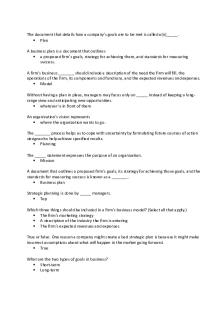#4 - None PDF

| Title | #4 - None |
|---|---|
| Author | krissy Swagnificent |
| Course | Maternity Labor |
| Institution | Barry University |
| Pages | 2 |
| File Size | 45 KB |
| File Type | |
| Total Downloads | 70 |
| Total Views | 173 |
Summary
None...
Description
True/False 1. A large-for-gestational-age newborn typically weighs more than 4,000 g (8 lb 13 oz). T 2. Newborns who are small for gestational age have intrauterine growth restriction. F 3. A newborn born at 41 weeks’ gestation would be classified as post term. F 4. The respiratory system is one of the first systems to mature in the fetus. F 5. A preterm newborn has abundant vernix caseosa. T
Fill-in-the-Blank 1. A baby born at 35 weeks’ gestation is classified as a Late preterm newborn. 2. Preterm newborns have a limited ability to digest Protein. 3. Preterm newborns have an Increased risk for drug toxicity. 4. Preterm newborns can develop respiratory distress syndrome due to a deficiency of Surfactant. 5. The preterm newborn loses heat via Conduction if placed on a cold examining table.
True/False 1. A newborn with transient tachypnea of the newborn typically requires mechanical ventilation. F 2. Meconium may be passed in utero secondary to hypoxic stress. T 3. Periventricular-intraventricular hemorrhage is a common problem of preterm infants. T 4. The most common cranial nerve trauma involves the facial nerve. T 5. Fetal alcohol syndrome is rarely preventable. F
Fill-in-the-Blank
1. A newborn who fails to establish adequate, sustained respiration after birth is experiencing Asphyxia. 2. The chest x-ray of a newborn with respiratory distress syndrome typically shows a ground Glass pattern. 3. A newborn of a substance-abusing mother who demonstrates neurologic and physical behaviors associated with withdrawal is experiencing neonatal Abstinence Withdrawal syndrome. 4. Hyperbilirubinemia is exhibited as jaundice. 5. Gastroschisis refers to a herniation of abdominal contents through an abdominal wall defect....
Similar Free PDFs

#4 - None
- 2 Pages

Week 11- WSJ#4 - None
- 3 Pages

Acyclovir - none
- 3 Pages

CH 6 num 4 ACCT 2000 - none
- 1 Pages

L01 - None
- 3 Pages

8 - None
- 16 Pages

MAN5 - none
- 4 Pages

BIG Ideas - none
- 5 Pages

Phet Lenses (2) - none
- 2 Pages

Brochure SCI - None
- 20 Pages

Final EXAM Llorente - none
- 1 Pages

STAT 3025Q Syllabus - NONE
- 4 Pages

MCQ module 1 - none
- 13 Pages

Alzheimer\'s Disease - none
- 11 Pages

Tax 2 - NONE
- 10 Pages
Popular Institutions
- Tinajero National High School - Annex
- Politeknik Caltex Riau
- Yokohama City University
- SGT University
- University of Al-Qadisiyah
- Divine Word College of Vigan
- Techniek College Rotterdam
- Universidade de Santiago
- Universiti Teknologi MARA Cawangan Johor Kampus Pasir Gudang
- Poltekkes Kemenkes Yogyakarta
- Baguio City National High School
- Colegio san marcos
- preparatoria uno
- Centro de Bachillerato Tecnológico Industrial y de Servicios No. 107
- Dalian Maritime University
- Quang Trung Secondary School
- Colegio Tecnológico en Informática
- Corporación Regional de Educación Superior
- Grupo CEDVA
- Dar Al Uloom University
- Centro de Estudios Preuniversitarios de la Universidad Nacional de Ingeniería
- 上智大学
- Aakash International School, Nuna Majara
- San Felipe Neri Catholic School
- Kang Chiao International School - New Taipei City
- Misamis Occidental National High School
- Institución Educativa Escuela Normal Juan Ladrilleros
- Kolehiyo ng Pantukan
- Batanes State College
- Instituto Continental
- Sekolah Menengah Kejuruan Kesehatan Kaltara (Tarakan)
- Colegio de La Inmaculada Concepcion - Cebu
